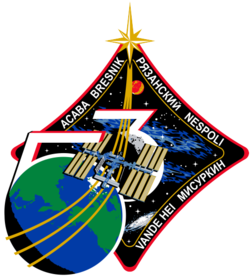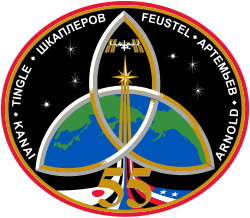Expedition 54
| Expedition 54 | |||
 | |||
| Uppdragsstatistik | |||
|---|---|---|---|
| Rymdstation: | ISS | ||
| Start: | 14 december 2017[1] | ||
| Slut: | 27 februari 2018 | ||
| Antal besättningsmedlemmar: | 6 st | ||
| Rymdpromenad | |||
| Antal rymdpromenader: | 3 st | ||
| Total tid: | 21 tim, 34 min | ||
| Transport | |||
| Uppskjutning: | med Sojuz MS-06, Sojuz MS-07 | ||
| Uppskjutningsplats: | Kosmodromen i Bajkonur | ||
| Landning: | med Sojuz MS-06, Sojuz MS-07 | ||
| Landningsplats: | Kazakstan | ||
| Kronologi | |||
| |||

Expedition 54 är den 54:e expeditionen till Internationella rymdstationen (ISS). Expeditionen började den 14 december 2017 då delar av Expedition 53s besättning återvände till jorden med Sojuz MS-05.
Anton N. Sjkaplerov, Scott D. Tingle och Norishige Kanai anlände till stationen med Sojuz MS-07 den 17 december 2017.
Expeditionen avslutades 27 februari 2018, då Aleksandr Misurkin, Mark T. Vande Hei och Joseph M. Acaba återvände till jorden med Sojuz MS-06.
Besättning
| Position | Första delen (14 - 17 december 2017) | Andra delen (17 december 2017 - 27 februari 2018) |
|---|---|---|
| Befälhavare | Hans andra rymdfärd | |
| Flygingenjör 1 | Hans första rymdfärd | |
| Flygingenjör 2 | Hans tredje rymdfärd | |
| Flygingenjör 3 | Hans tredje rymdfärd | |
| Flygingenjör 4 | Hans första rymdfärd | |
| Flygingenjör 5 | Hans första rymdfärd | |
Referenser
- ^ NASA's Space Station Expedition 54 Arkiverad 18 juli 2019 hämtat från the Wayback Machine., läst 14 december 2017.
Externa länkar
| |||||||||||||||||||
Media som används på denna webbplats
The Expedition 54 crew insignia
- Orbiting Earth continuously since 1998, the International Space Station (ISS) is one of our greatest engineering achievements. It is depicted in gold, symbolic of constancy and excellence. Flying toward a sunrise represents the station’s contributions to a bright future. That sunrise uses blue, white, and red, the combined national colors of Japan, Russia, and the United States, symbolizing the crew’s cohesiveness. Crewmember names are in blue, symbolizing devotion and loyalty.
- The gold border represents the constant human presence in space onboard the orbiting laboratory. Symbolic of new Russian and U.S. spacecraft that will advance human exploration, the patch is shaped as a capsule. The number 54 is drawn as a path eventually leading to Mars.
- Finally, the stars symbolize the values of leadership, trust, teamwork, and excellence lived by mission control teams throughout the history of human space programs, as well as the global vigilance of those teams while operating the station.
The Expedition 53 crew insignia
- The International Space Station is our launch pad into the future of human space exploration. Collectively, our world stands at the cusp of incredible developments as a spacefaring species. Onboard the space station we continue to evolve the technologies vital to the sustainment and longevity of humans in the harsh realities of living without gravity or the protection of our atmosphere. These self-sustaining or regenerative technologies continually developed aboard the space station not only improve life here on Earth, but they are essential to human beings existence beyond low-Earth orbit (LEO).
- The space station is the linchpin for this next great phase of development and is instrumental in expanding the use of space, not only as a worldclass science laboratory, but also as a destination for next-generation space vehicles. This journey beyond LEO is depicted in the Expedition 53 patch as we, the crew, will endeavor to accomplish the work that allows future missions to further explore our solar system. This journey will only be accomplished as an international team, represented by our multinational crew as well as by the many countries depicted on the globe.
- The myriad of stars represent the untold number of passionate and supremely dedicated people that endeavor across the planet daily to make the space station the amazing vehicle it is as well as prepare us for the next great steps forward in space exploration.
The six-member Expedition 54 crew poses for an official crew portrait at the Johnson Space Center in Houston, Texas. From left are Flight Engineers Joe Acaba and Mark Vande Hei of NASA, Commander Alexander Misurkin of Roscosmos and Flight Engineers Anton Shkaplerov of Roscosmos, Scott Tingle of NASA and Norishige Kanai of the Japan Aerospace Exploration Agency.
The official mission insignia of the Expedition 55 crew.
- The six crew members of Expedition 55 are patriots from three different countries – Japan, Russia, and the United States. The crew from these three countries will work together to ensure the success of Expedition 55.
- The three rings symbolize the three countries of the six crew members. The rings join in a common intersection, symbolizing collaboration and a common focus for the crew aboard the space station. The colors of the rings represent the energy and power required to carry humans and equipment into space and to operate the ISS. The colors blue and green represent the magnificent beauty of Earth. The color black represents the darkness of space, and the immense challenge of exploring space. The six stars represent the crew, Norishige Kanai, Scott Tingle, Anton Shkaplerov, A.J. (Drew) Feustel, Oleg Artemyev, and Ricky Arnold. The three flags are the flags representing each crew member’s country. The swoosh extending upward towards space represents the dedication of cosmonauts, astronauts and a multinational support team working together to explore space and discover new science that will benefit all humans.






